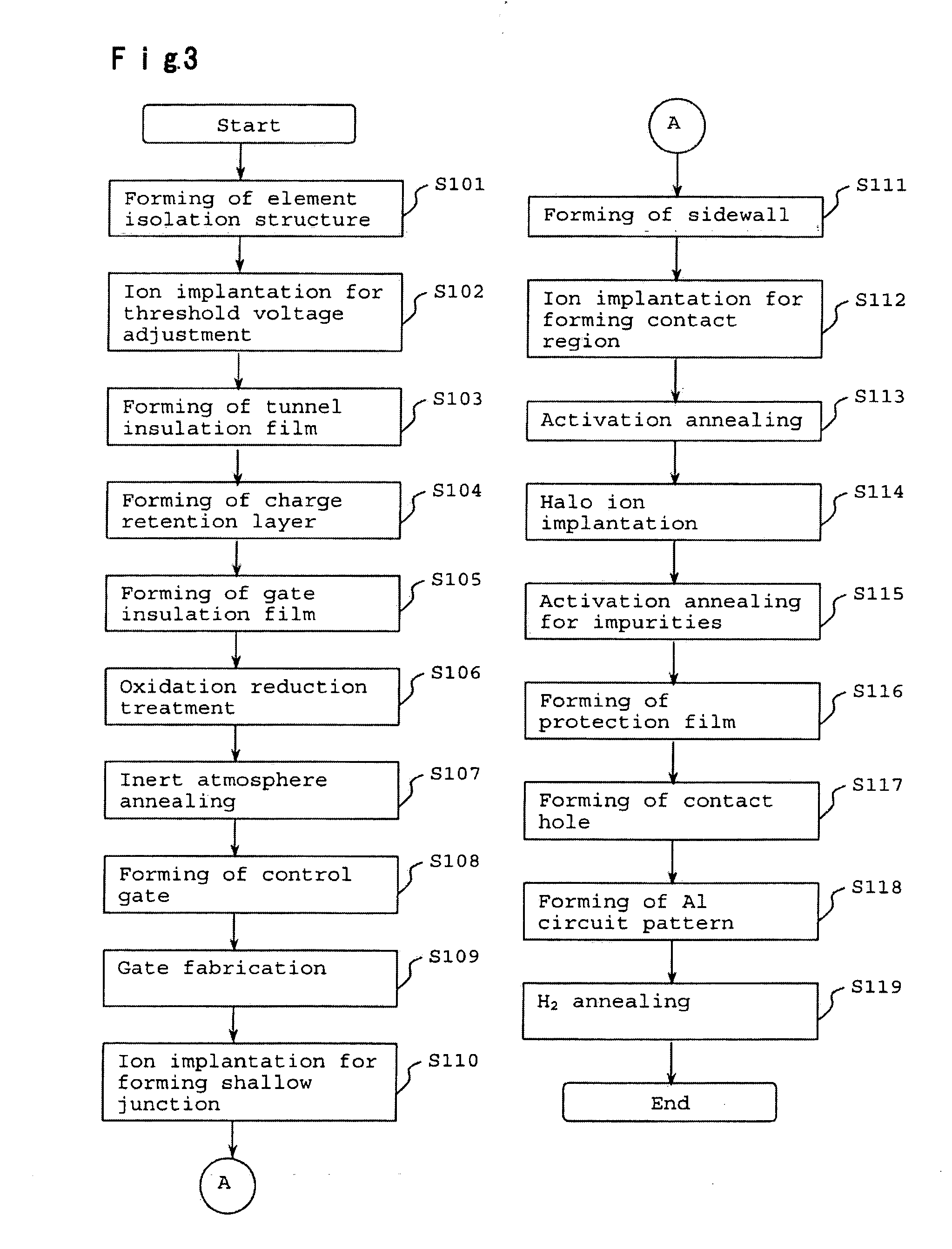Nonvolatile semiconductor memory element excellent in charge retention properties and process for producing the same
a semiconductor memory element and charge retention technology, applied in the direction of semiconductor devices, basic electric elements, electrical appliances, etc., can solve the problems of difficult formation of a thin film of insulators surrounding the floating gate of a flash memory, progress toward high performance, and difficulty in forming a thin film of insulators
- Summary
- Abstract
- Description
- Claims
- Application Information
AI Technical Summary
Benefits of technology
Problems solved by technology
Method used
Image
Examples
embodiment
[0097]FIG. 1 is an explanation view schematically showing an example of cross sectional structure of a nonvolatile semiconductor memory element according to an embodiment of the present invention. In FIG. 1, a nonvolatile semiconductor memory element 100 is formed on a semiconductor substrate 1, and is isolated by element isolation 2. Here, the semiconductor substrate 1 in FIG. 1 is a semiconductor substrate of p-type, and the element isolation 2 is one formed by using a STI (Shallow Trench Isolation) technique.
[0098]The nonvolatile semiconductor memory element 100 has a structure that on the semiconductor substrate 1, a tunnel insulation film 3, a charge retention layer 4 for retaining an electric charge, a gate insulation film 5 and a control gate 6 laminated in this order. The charge retention layer 4 has a structure that ultrafine particles 4a1 functioning as a floating gate is dispersed in a matrix insulator 4b with high density.
[0099]Here, the control gate 6 forms a channel on...
example 1
[0154]FIG. 3 is a process flow chart for explaining a process for producing nonvolatile semiconductor memory element according to Example 1. In this Example, process steps for producing peripheral circuit portions such as element selection transistors or signal amplification circuit, are omitted, and only process steps for producing memory elements are described.
[0155]First of all, element isolations 2 are formed on a surface of a semiconductor substrate 1 made of a single crystal Si doped with p-type impurities (S101; refer to FIG. 4). Then, ion implantation for adjusting threshold voltage is carried out (S102; refer to FIG. 5). Here, before this ion implantation, a film called as screen oxide film 21 schematically shown in FIG. 5 is formed by using Si thermal oxidation. As ions to be implanted, BF2+ ions are employed, and the semiconductor substrate is tilted by 7° to the incident direction of implanted ions so that the implanted ions do not cause channeling of the semiconductor s...
example 2
[0173]FIG. 17 is an explanation view schematically showing an example of cross sectional structure of a nonvolatile semiconductor memory element according to Example 2. First of all, in the same manner as explained in Example 1, on a surface of a semiconductor substrate 1 made of single crystal Si doped with p-type impurities, element isolations 2 are formed (S101; refer to FIG. 4), and ion implantation is carried out to adjust threshold voltage (S102; refer to FIG. 5).
[0174]Then, the above-mentioned screen oxide film 21 (refer to FIG. 5) is removed so that the surface of the semiconductor substrate 1 is exposed, and a tunnel insulation film 23 is formed on the surface of the semiconductor substrate 1 (S103; refer to FIG. 18). The forming of the tunnel insulation film 23 is carried out by thermally oxidizing and nitriding the surface of the semiconductor substrate 1 in a N2O atmosphere to form a SiO0.5N film. Here, the thickness of the tunnel insulation film 23 is made to be 3 nm.
[0...
PUM
 Login to View More
Login to View More Abstract
Description
Claims
Application Information
 Login to View More
Login to View More - R&D
- Intellectual Property
- Life Sciences
- Materials
- Tech Scout
- Unparalleled Data Quality
- Higher Quality Content
- 60% Fewer Hallucinations
Browse by: Latest US Patents, China's latest patents, Technical Efficacy Thesaurus, Application Domain, Technology Topic, Popular Technical Reports.
© 2025 PatSnap. All rights reserved.Legal|Privacy policy|Modern Slavery Act Transparency Statement|Sitemap|About US| Contact US: help@patsnap.com



